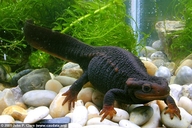|
Tylototriton verrucosus Anderson, 1871
Himalayan Newt, Red Knobby Newt Subgenus: Tylototriton | family: Salamandridae subfamily: Pleurodelinae genus: Tylototriton |
| Species Description: Nussbaum, R. A., Brodie, Jr., E. D., Yang, D. 1995. A Taxonomic Review of Tylototriton verrucosus Anderson (Amphibia: Caudata: Salamandridae). Herpetologica, 51(3): pp. 257-268. | |
 © 2001 John P. Clare (1 of 57)
|
|
|
|
Description Distribution and Habitat Country distribution from AmphibiaWeb's database: Bhutan, China, India, Myanmar, Nepal, Thailand, Viet Nam
Life History, Abundance, Activity, and Special Behaviors Trends and Threats Relation to Humans Comments A molecular phylogenetic analysis of a population from Doi Chang, Chiang Rai Province, in Thailand found that there were cryptic clades nested within T. verrucosus from China. They also had morphological traits similar to T. verrucosus. These results lead to the confirmation of the existence of T. verrucosus in Thailand and the conclusion the habitats of T. verrucosus need to be protected by future conservation plans. (Pomchote et al 2020).
References
Annandale, N. (1908). ''Breeding habits of Tylototriton verrucosus.'' Records of the Indian Museum, 2, 305-306. Chaudhuri, S.K. (1966). ''Studies on Tylototriton verrucosus (Himalayan Newt) found in Darjeeling.'' Journal of the Bengal Natural History Society, 35(1), 32-36. Dasgupta, R. (1984). ''Parental care in the Himalayan Newt.'' Journal of the Bengal Natural History Society, 3(2). Dasgupta, R. (1990). ''Distribution and conservation problems of the Himalayan Newt (Tylototriton verrucosus) in the Darjeeling Himalayas.'' Hamadryad, 15(1), 13-15. Dutta, S.K. (1990). Amphibians of India and Sri Lanka (Checklist and Bibliography). Odyssey Publishing House, Bhubaneswar. Fei, L. (1999). Atlas of Amphibians of China. Henan Publishing House of Science and Technology, Zhengzhou. Kuzmin, S.L., Dasgupta, R. and Smirina, E.M. (1994). ''Ecology of the Himalayan newt (Tylototriton verrucosus) in Darjeeling Himalayas,India.'' Russian Journal of Herpetology, 1(1), 69-76. Pomchote, P., Khonsue, W., Sapewisut, P., Eto, K., & Nishikawa, K. (2020). Discovering a Population of Tylototriton verrucosus (Caudata: Salamandridae) from Thailand: Implications for Conservation. Tropical Natural History, 20(1), 1-15. [link] Shrestha, T.K. (1989). ''Ecological aspects of the life-history of Himalayan Newt Tylototriton verrucosus (Anderson) with reference to conservation and management.'' Journal of the Bombay Natural History Society, 86(3), 333-338. Taylor, E.H. (1962). ''The amphibian fauna of Thailand.'' University of Kansas Scientific Bulletin, 43(8), 265-599. Thorn, Robert (1968). Les Salamandres d'Europe, d'Asie et d'Afrique du nord. Lechevalier, Paris. Ye, C., Fei, L., and Hu, S. Q. (1993). Rare and Economic Amphibians of China. Sichuan Publishing House of Science and Technology, Chengdu. Zhang, M., Rao, D., Yu, G., and Yang, J. (2007). ''The validity of Red Knobby Newt (Tylototriton shanjing) species status based on mitochondrial Cyt b gene.'' Zoological Research, 28(4), 430-436. Zhao, E. and Adler, K. (1993). Herpetology of China. Society for the Study of Amphibians and Reptiles, Oxford, Ohio. Zhao, E. and Zhao, H. (1994). Chinese Herpetological Literature: Catalogue and Indices. Chengdu University of Science and Technology, Chengdu. Ziegler, T., Hartmann, T., Van der Straeten, K., Karbe, D., and Böhme, W. (2008). ''Captive breeding and larval morphology of Tylototriton shanjing Nussbaum, Brodie and Yang, 1995, with an updated key of the genus Tylototriton (Amphibia: Salamandridae).'' Der Zoologische Garten, 77, 246-260. Originally submitted by: Sergius L. Kuzmin, Michelle S. Koo (first posted 1999-11-10) Edited by: Kellie Whittaker (2021-03-18) Species Account Citation: AmphibiaWeb 2021 Tylototriton verrucosus: Himalayan Newt <https://amphibiaweb.org/species/4309> University of California, Berkeley, CA, USA. Accessed May 17, 2025.
Feedback or comments about this page.
Citation: AmphibiaWeb. 2025. <https://amphibiaweb.org> University of California, Berkeley, CA, USA. Accessed 17 May 2025. AmphibiaWeb's policy on data use. |





 Raffaëlli Account
Raffaëlli Account Map of Life
Map of Life